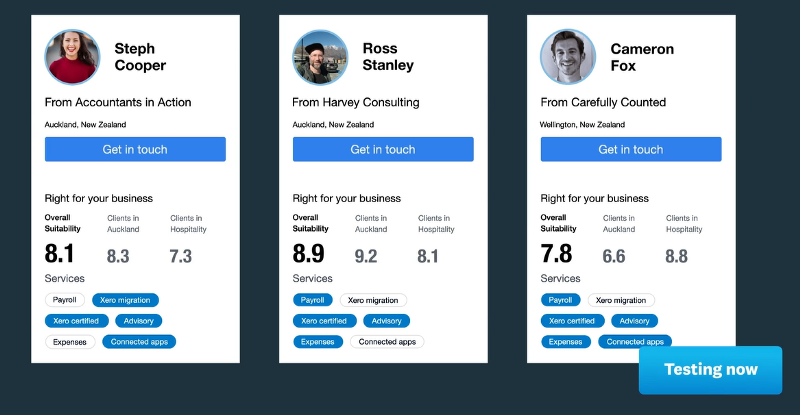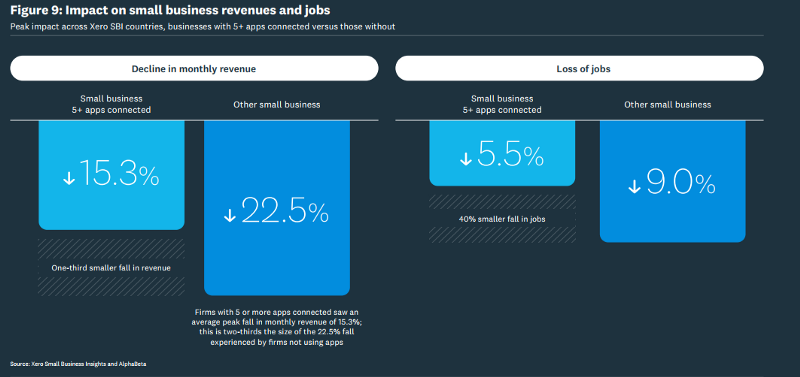Xero, a beautiful business model
At ECP, we continually assess the quality and the sustainability of our investments to evaluate the strength of their competitive advantage through time. Xero is a notable portfolio company which continues to demonstrate a deepening competitive advantage; here, we present some of the learnings that may be useful for investors.
Recently we published ‘Competitive advantages of Australia's tech titans’, which explored different types of network effects and how to measure their varying strengths.
In this article, we expand on this framework by providing a case study on Xero to illustrate the lessons learned that could be used to determine future great business models. Specifically:
- The two-sided accounting ledger — network effect or trusted middleman?
- The flywheel effect of increasing scale
- The emerging lock-in from practice management software
- The ecosystem advantage and the latent opportunity it creates
The Two-sided Accounting Ledger — Network Effect or Trusted Middleman?
Xero’s core product is a cloud-based, single source of truth, accounting ledger with real-time reconciliation that sits between accountants and small-medium-enterprises (SME). The product streamlines the maintenance of financial records for regulatory and tax purposes.
Xero’s platform is extremely “sticky” because it adds value to both accountants and their clients. If an accountant decides to switch platforms, they need to notify their clients, ask them to change, and teach both their clients and staff how to use a new system. An SME can decide to switch, but if the accountant benefits from the Xero platform they will encourage their client to stay on the Xero ledger.
This is a ‘trusted middleman’ model — where a trusted distributor heavily influences the customer’s decision. Trusted middleman models often result in lower churn and higher pricing power. The decision-maker is choosing the product but not paying for it.
The model has existed for decades in accounting software with MYOB leveraging the same approach, allowing it to become the dominant player in the 1990s. In fact, this was such an effective business model that it took a major technology shift from on-premise to the cloud and an innovative new entrant (Xero) to dislodge MYOB’s market position. It is due to the legacy “trusted middleman” model that MYOB has hung on to market share and remains a relevant competitor today.
While the trusted middleman model is not a network effect by strict definition, we believe it creates network benefits for Xero through its emerging lead generation capability for accountants.
Xero has a Partner Directory (pictured below) that it is positioning as an accountant marketplace. Increasingly Xero is matching small businesses to accountants that are most suited to them.

This specific service creates network benefits where the more businesses on Xero, the more utility an accountant will receive from the platform. Conversely, the more accountants on the platform, the better outcome for a small business searching for an accountant.
The Flywheel Effect of Increasing Scale
Often confused with network effects, the flywheel is a concept made famous by Jim Collins and Amazon. It is a formula specific to a business where investing in particular areas drives business momentum so that incremental growth requires less incremental investment.
Amazon’s flywheel famously leverages its customer experience to drive traffic to the platform and 3rd party sellers; this improves the selection of goods which lowers Amazon’s cost structure, leading to decreased prices and improved customer experience, i.e. spinning the wheel.
We have met with companies in the past that describe this as a network effect. The growing user base provides more revenue to invest in additional product features that attract more users and drive revenue. This is better described as increasing returns from scale (a flywheel effect).
Scale is a legitimate Sustainable Competitive Advantage (SCA) that we value in its own right. However, a user scale advantage may be (swiftly) displaced by a looming tech giant creeping into your industry.
As an example, a company may be gaining scale with an innovative fitness wearable on your wrist, until one day the Apple watch comes along doing fitness and much more. All of a sudden scale doesn’t give you much of an advantage.
Xero’s flywheel has been an important feature in its market share battle with MYOB in Australia. While there are several reasons Xero has been able to take market share from MYOB, a key reason for its success lies in the scaling of its platform across multiple geographies.
This flywheel has allowed Xero to scale its codebase investment to bring features to a broader (global) audience. In contrast, MYOB has focused on going into deeper Australian based use cases. As Xero’s platform scales across the globe, it will only get harder for MYOB to keep up with Xero’s feature-rich platform.
The Emerging Lock-in from Practice Management Software
Practice management software is becoming an essential tool to reduce churn and increase customer captivity. Xero’s greatest barrier to competition is providing innovative solutions to both its small business customers and accountant partners that save them time and money. However, survey data published by UBS indicates that the accountants are highly influential in the decision on which accounting ledger SMEs adopt.
In our view, practice management software is key to gaining and maintaining market share. Practice management software is a tool that accountants use to manage their practice’s workflow, time tracking and job costing. With practice management deeply integrated into the accounting ledger platform, accountants can achieve significant workflow efficiency that saves time and money.
With increasing cloud adoption in Australia, most small businesses are now using a cloud-based ledger, so it is natural that most accounting practices are now looking to decide what practice management software to deploy to make the most of this data.
Naturally, Xero is a strong choice with the highest market share of accounting ledgers — if most of your clients are using Xero, then you will get the most efficiency with Xero’s Practice Manager (XPM).
However, accountant feedback on XPM has been mixed to date, and this could prove to be a strategic misstep on Xero’s part. In a world where accountant practice management tools and billable workflows are serviced by Xero app partners, such as Practice Ignition instead of Xero itself, the process of switching software providers is much more streamlined — increasing the risk of churn.
Recent releases at Xero’s digital conference “Xero on Air” suggests they are improving these features by more deeply integrating XPM into the workflow of the XeroHQ platform. Further, management indicated that product development is increasingly turning XeroHQ into a purpose-built CRM system for Accountants and bookkeepers.
Suppose Xero can increase the adoption of practice management software with its accounting partners. In that case, the risk of churn reduces, increasing the durability of the company’s revenues as well as its long term pricing power. A beautiful business.
The Ecosystem Advantage and the Latent Opportunity it Creates
Xero’s software has direct integrations with ~200 bank and financial service partners and is open to developers to build third-party applications for sale in its marketplace, with 800 and counting. Here, a two-sided network is created between developers and accountants (e.g., practice management software) as well as SMEs (e.g., inventory management).
As accountant and SME participants grow, it attracts more developers to build niche applications and more financial services to build direct integrations, increasing participant functionality and captivity, without the additional capital cost for Xero. The ecosystem is a network effect, the strength of which is unclear.
Xero has not disclosed the level of attach rates; these third-party applications and financial services partnerships are rarely exclusive to the Xero platform (i.e. developer multi-housing). Recent feedback has indicated that these solutions are more stable and feature-rich when used with Xero compared to other competitors.
While not exclusive to Xero, the ecosystem still does narrow the competitive landscape to an oligopoly market structure. Developers are unwilling to integrate with every platform available for little incremental access to customers. We see similarities to the developer dynamics in the operating systems iOS and Android.

While we are uncertain as to the current strength of the network effect, we do expect it to increase in importance over time, with clear evidence of users benefiting from the ecosystem. The figure below from Xero’s pandemic insights publication illustrates the improved performance through COVID-19, of small business with 5+ apps connected to Xero.
Xero is central to SME financial management. We expect Xero’s platform to become increasingly powerful to all participants driven by deeper ecosystem integrations, partnerships with payment providers such as Stripe and GoCardless as well as the emergence of Open Banking around the world.
Ultimately this leads to increasing monetisation of this asset in the long term. Xero’s recent acquisition of Waddle is further progress in this regard.

Beautiful Business Models
At ECP, we look for a talented management team with a sustainable business model that combine to create a Quality Franchise. Recent economic uncertainty only heightens the need to be invested in these quality businesses which employ the most robust business models.
Xero has a well-crafted strategy, and the many aspects of its business model give us confidence in its ability to compete in its market, grow its economic footprint and generate strong returns on capital into the long term.
We spend a lot of time focusing on what resources drive a company’s Sustainable Competitive Advantage (SCA). Sometimes a business comes along that has several attractive attributes contributing to its competitive advantage. Identifying and studying the factors that contribute to the sustainability of this advantage provide us with lessons that we can leverage to find the next Quality Franchise.
Not already a Livewire member?
Sign up today to get free access to investment ideas and strategies from Australia’s leading investors.
2 topics
1 stock mentioned

